Andhra cuisine
This article needs additional citations for verification. (September 2019) |
| Part of a series on the |
| Culture of Andhra Pradesh |
|---|
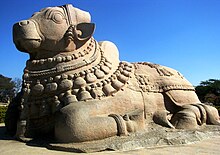 |
| History |
| People and culture |
| This article is part of the series on |
| Indian cuisine |
|---|
 |
Andhra cuisine, culturally known as Telugu cuisine, is a cuisine of India native to the state of Andhra Pradesh and is the culinary style of Telugu people. It is generally known for its tangy, hot, and spicy taste.

Regional variations[edit]
This section needs additional citations for verification. (September 2019) |
The regions of Coastal Andhra (including Uttarandhra and Dakshinandhra), and Rayalaseema all produce distinctive variations of Andhra cuisine. Rice is the staple in the irrigated regions of Andhra and Rayalaseema. Ragi (రాగి) is also popular in Rayalaseema and Palnadu. The curries, snacks, and sweets produced in these areas vary in both name and method of preparation from region to region.
Andhra Pradesh is the leading producer of red chili and rice in India. The concentration of red chili production in Andhra Pradesh has led to the liberal use of spices in Andhra cuisine. Vegetarian dishes, as well as meat, and seafood in coastal areas, feature prominently. Tomato pappu, gongura, and tamarind are widely used for cooking curries. Spicy and hot varieties of pickles are also an important part of Andhra cuisine, including avakaya (ఆవకాయ). "Deltaic" cuisine from Guntur in Coastal Andhra is known as the spiciest variety of Andhra cuisine, primarily because of the use of red chilis traditionally grown in the region.
The eating habits of Hindu royals and Brahmins have historically had a heavy influence on Andhra cuisine. Andhra Pradesh's proximity to Western, Central, and Eastern India influenced the diversity of those border regions' cuisine as well, as the Telugu-speaking population spread into neighboring states. Different communities have developed their own variations, and rural areas still follow centuries-old cooking methods and recipes.
Coastal Andhra[edit]
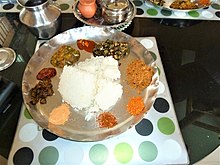


Coastal Andhra is dominated by the Krishna and Godavari river delta regions and is adjacent to the Bay of Bengal. This proximity to water has led to rice, lentils, and seafood becoming dietary staples in the region. Andhra cuisine has its own variations, but dishes are predominantly rice-based. The Nellore region in the south has its own unique recipes, markedly different from those in Uttarandhra. Ulava charu (ఉలవచారు) is a soup made from horse gram,[1] and bommidala pulusu (బొమ్మిడాల పులుసు) is a seafood stew that is considered a specialty of Andhra Pradesh. Andhra cuisine is prevalent in restaurants all over Andhra Pradesh, as well as in cities like Bangalore, Chennai, and New Delhi.
The Uttarandhra region is composed of the northeastern districts of Srikakulam, Vizianagaram, and Visakhapatnam in Coastal Andhra. While Visakhapatnam district has a cuisine closer in character to the rest of Andhra's districts, Vizianagaram and Srikakulam cuisine shares less in common with other Andhra regional cuisines. The food of the Uttarandhra region is often sweeter than in other regions of Andhra Pradesh. Lentils are often cooked in jaggery, a dish referred to as bellam pappu (బెల్లం పప్పు) and are usually served with butter and steamed rice.
Vegetables are often cooked in a gravy of menthi kura (మెంతి కూర) (fenugreek seed paste), avapettina kura (ఆవపెట్టిన కూర) (mustard seed paste), or nuvvugunda kura (నువ్వుగుండ కూర) (sesame paste). Ullikaram is another popular dish in which vegetables or corn seeds are flavored with shallots or onion paste.
Poori (పూరి) and patoli are popular breakfast or festival dishes. Patoli is composed of soaked split black chickpeas (senagapappu (శనగపప్పు) or chana dal) ground to a coarse paste and seasoned with coriander seeds, onions, and sometimes cluster beans (goruchikkudukaya) (గోరుచిక్కుడుకాయ). Upma or uppindi (ఉప్పిండి) coarsely broken rice steamed with vegetables and seeds.[2] This dish is eaten on feast days, when people fast during the day and eat at night. Attu (అట్టు) also called dosa (దోశ) is a standard breakfast in Andhra Pradesh, which may also include coconut or tomato chutneys. Idli (ఇడ్లీ) is also very common. Karam podi (కారం పొడి) is a popular curry powder that is served with idli, dosa and upma.
Inguva charu (ఇంగువ చారు) is a sweet-and-sour stew made with tamarind and hing. It can be eaten with rice or uppupindi. Bellam pulusu (బెల్లం పులుసు) is another flavorful, thick, sweet stew made out of rice flour, jaggery, corn cobs, and whole shallots.
The pickles used in Uttarandhra differ from those of other regions of Andhra Pradesh. Avakaya (ఆవకాయ) is a mango pickle which is part of a standard Andhra meal. Pieces of mango are coated with mustard powder, red pepper powder, and salt, then sun-dried, and finally soaked in sesame oil to give the pickle extended shelf life. The result of this process is a darker hue and a sweeter taste than other pickles. This method helps preserve Uttarandhra pickles better amidst the high moisture from the Bay of Bengal coast.
Rayalaseema[edit]
Rayalaseema, in the south of Andhra Pradesh, is well-known for the spiciness of its cuisine due to the liberal use of chili powder in almost every dish. Seema karam (సీమ కారం) is a dish unique to this region. Some of the main courses include rice, jonna (జొన్న) (jowar), ragi roti (రాగి రోటి) with neyyi (నెయ్యి), and raagi sangati (రాగి సంగటి), usually served with spinach or pulusu. Uggani (ఉగ్గాని) is a dish unique to Rayalaseema, especially Ananthapur, Kurnool, and Kadapa districts, as well as in Karnataka, where it is called oggane. It is made with boiled paddycorn and is generally yellowish in color due to heavy use of turmeric powder. It is usually served with mirapakaya bajji (మిరపకాయ బజ్జి) (chili "bajji"). Uggani bajji (ఉగ్గాని బజ్జి) served primarily as a breakfast dish, but can be eaten as a snack too. It is spicy and a signature dish of Rayalaseema and Eastern Karnataka.[3]
Sweeter dishes of Rayalaseema include ariselu (అరిసెలు) (rice-based vada with jaggery), pakam undalu (పాకం ఉండలు) (a mixture of steamed rice flour, ground nuts, and jaggery), borugu undalu (బొరుగు ఉండలు) (a sweet made of jowar and jaggery), and rava laddoo (రవ్వ లడ్డూ). Masala borugulu (మసాలా బొరుగులు), nargis mandakki, and ponganaalu (పొంగణాలు) (wet rice flour fried in oil, with carrot, onion, and chilis) are other savory specialties from the region.
Breakfast[edit]
A typical Andhra breakfast consists of a few of the items listed below. Usually it consists of idli, garelu a.k.a. vada (deep-fried lentil dough), minapattu, also known as dosa, (a rice- and lentil-based pancake or crepe). Tea, coffee with milk, or simply milk often accompany these dishes. The most common dishes consumed for breakfast are:
- 'Idli', Urad dal and rice steamed rice cakes, often eaten with freshly-made chutney or with neyyi added and sprinkled with karrap podi (chili dal powder) or chutney and sambar.

- Andhra dosa, a rice- and urad dal-based crepe eaten with chutney and sambar.
- Minapattu, a rice- and lentil-based crepe, served with chutney and sambar
- Pesarattu, a green gram-based crepe. It is usually served with ginger chutney. Sometimes pesarattu is filled with upma, in which case it is known as upma pesarattu.
- Dibba attu, a deep-fried dosa made with idli batter
- Atukula dosa, a dosa made from atukulu, a.k.a. poha.
- Rava (Suji) dosa, a dosa made with sooji dough with chili, coriander leaves, onion, and pepper.

- Andhra upma
- Godhuma uppindi, upma made from broken wheat flour
- Pesarpindi uppindi, a dry porridge made of green gram flour. Commonly served with yoghurt or mango-jaggery pickle.
- Pulusu uppindi, a dry porridge made with rice flour, peanuts, and tamarind extract. Commonly served with yoghurt or mango-jaggery pickle.
- Beeyam rava pesara pappu, literally translated as "made with broken rice and hulled green gram". Commonly served with yoghurt or mango-jaggery pickle.
- Varipindi uppindi, a dry porridge made with rice flour and hulled green gram. Commonly served with yoghurt or mango-jaggery pickle.
- Uppudu pindi or uppindi a.k.a. upma, a porridge made from broken sooji flour, ghee, and vegetables. Commonly served with buttermilk or a spicy-savoury powder made from pulses.
- Saggubiyyam (sago) upma, an upma made from sago (saboodana).
- Semiya upma, an upma made with vermicelli.
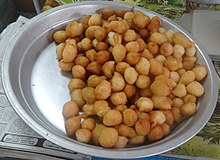
- Vada
- Garelu, a deep-fried lentil-based doughnut, or sometimes a deep-fried dal mixture.
- Punukulu or Punugulu, a.k.a. Bonda, a deep-fried dish made from idli/dosa batter.
- Gunta punugulu, made from rice and dal batter
- Saggubiyyam punugulu, vada made from sago (saboodana).
- Mung dal punugulu, or bonda, a deep-fried dish made from idli/dosa batter.
- Thapala chekkalu, a deep-fried rice and dal-based flat vada with onions, curry leaves, and chili.
- Atukulu/poha
- Atukulu, also known as poha in the northern states; moist rice flakes sautéed in oil.
- Atukula dosa, dosa made from atukulu a.k.a. poha.
- Atukula upma, upma made from atukulu, replacing sooji with atukulu.
- Bread and roti
Lunch and dinner[edit]
This section needs additional citations for verification. (September 2019) |
Great effort is put into preparing lunch and dinner in many Telugu households. In most urban households, the food is served on stainless steel or porcelain plates, while in traditional and rural households, the food may be served on a banana leaf. The banana leaf is often used during festivals, special occasions, and for guests. Many middle-budget restaurants in smaller towns also use banana leaves for serving food. At times, a vistaraaku (a larger plate made of several leaves sewn together) is used. Sun-dried banana leaves have also traditionally been used to package food for personal use on long journeys.
A complete vegetarian Andhra meal typically consists of rice served with ghee, pulihora, chapati or puri, pappu (lentils), sambar, chaaru (rasam), fried and wet curries, appadam (papadum), odiyalu, chutney, pachadi, avakaya, yoghurt and a sweet for dessert. In general, food from the Vijayawada-Guntur region contains more chili and spices than food from the rest of Andhra Pradesh. Rice is considered the main dish and everything else is considered a side.
Vegetarian dishes[edit]


Meal presentation[edit]
Pappu (dal/lentils) and kooralu (curries) are placed to the right of the diner, while spiced pickles, pachadi (chutney/raita), a saucy condiment with dahi (yogurt), vegetables, pappulu podi (dal and dry red chili-based powdered condiment), and neyyi (ghee) are placed to the left. On some occasions, special items such as pulihora (tamarind or lemon rice) and garelu (vada) are placed at the top right. A large scoop of annam (plain white rice) is placed in the middle. Small amounts of neyyi are added on the rice. Avakaya (mango pickle) and gongura (roselle leaf pickle) are often served with the meal.
Courses and servings[edit]

Rice is the main dish, eaten by mixing with the side dishes using the right hand, and the primary source of carbohydrates. Spiced pickles, pachadi, podi, and papadum (appadam) are typical side dishes.
A meal traditionally starts with modhati muddha (first bite), an appetizer of spiced pickle followed by a pappu (dal) dish, which can be made with vegetables added or eaten plain with a pickle. This constitutes the main source of protein for vegetarians. This is followed by a couple of koora varieties, which provide vitamins and minerals. A pappu or rasam (Telugu: charu), usually kadi, is the third course. The fourth course of the meal is either a perugu (curd or yoghurt) or majjiga (buttermilk) accompanied by a spicy pickle or other condiments.
After the meal, paan or somph (areca nut/betel on pan leaf) is traditionally offered. On festival days or other auspicious occasions, a sweet, usually paravannam, is served with the meal, which is usually eaten first.
Koora/kura/curry (main courses)[edit]
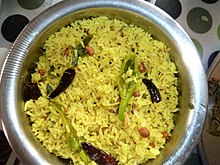




Koora — a generic word for a protein-based dish. Koora dishes are named for the ingredients used and the method of preparation. These methods include:
- Vepudu (fry): crispy fried vegetables, typically including okra (bendakaya), ivy gourd (dondakaya), potato (bangaladumpa), colocasia, and several additional local vegetables.
- Pappu koora (lentil-based dish): boiled vegetables stir-fried with a small amount of half-cooked lentils (dal).
- Podi (powdered dal-based condiment or seasoning): mixed with rice and a spoonful of ghee or sesame oil.
- Gujju (gravy): a tomato or coriander seed base into which is added into brinjal (gutthi vankaya), okra, etc.
- Pulusu (sour paste or gravy)
- Pulusu koora/Aava petti koora (stew): boiled vegetables cooked in tamarind sauce and mustard paste. Some varieties include potlakaya, anapakaya, bendakaya, gummadikaya.
- Kaaram petti koora/Koora podi koora (literally, "dish with curry powder added"): sautéed vegetables cooked with curry powder or paste, served as a solid mass. The vegetables can be stuffed with curry powder or paste and are usually cooked whole.
- Pappucharu (thick dal broth) or charu
- Charu a.k.a. rasam (clear soup)
- Ooragaya (pickle): avakaya, gongura, nimmakaya, etc.
- Pachadi (pasty/saucy condiment or chutney): kobbari (coconut), tomato, gongura, dosakaya, gummadikaya, and allam (ginger).
- Other gravy-based curries are usually made with vegetables cooked in tomato sauce and onion with coriander and cumin powder.
Pappu (dal)[edit]

Pappu (dal/lentils) dishes include toor daal (kandi pappu) and moong daal (pesara pappu), which are usually cooked with a vegetable or other green. No masala is added to the dal. In some areas, garlic and onion are included in the seasoning, while in others asafetida (hing/inguva) is used. Kandi pappu is often cooked with leafy vegetables such as palakura (spinach), gongura, malabar spinach, and other fruits and vegetables such as tomato, mango, or aanapakaya. Sometimes the cooked version of the dal is replaced with a roasted and ground version, like kandi pachadi (roasted toor daal ground with red chilis), or pesara pachadi (soaked moong daal ground with red or green chilis).
A very popular combination in Andhra is mudda pappu (plain toor dal cooked with salt) and avakaya.
Pulusu[edit]

Pulusu (meaning sour) is a curry-like stew that is typically sour and cooked with tamarind paste. Other common bases include tomatoes or mangoes. The mixture can be flavored with mustard, chilis, curry leaves, jaggery, onions, or fenugreek. Fish, chicken, and eggs are typical meat additions. Pachi pulusu is an unheated version of pulusu, typically made of mangoes or tamarind, and eaten during the warmer months.
- Majjiga pulusu: sour buttermilk boiled with channa dal and coconut paste
- Menthi challa/menthi majjiga: sour buttermilk seasoned with ginger or green chili paste and menthi (fenugreek) seeds, then fried in oil
- Mukkala pulusu or Dappalam (ముక్కల పులుసు or దప్పళం): pulusu made with aanapakaya(bottle gourd) and other vegetables
- Chammagadda pulusu: pulusu made with colocasia
- Kanda pulusu: pulusu made with yam
- Perugu (curd): the last dish of the meal, normally eaten along with pachadi or pickles
Pickles[edit]
Pachadi and ooragaya are two broad categories of pickle that are eaten with rice. Pachadi is the Telugu version of chutney, typically made of vegetables/greens/lentils and roasted green or red chilis, using tamarind and sometimes curds as a base. It is prepared fresh and must be consumed within two days due to having a short shelf life. Ooragaya is prepared in massive amounts each season. Preparation includes using large amounts of chili powder, as well as menthi (fenugreek) powder, mustard powder, and groundnut (peanut) oil or sesame or mustard oil. It is either consumed on its own, mixed with rice, or as a side dish with pappu/koora.
Non-vegetarian dishes[edit]
This section needs additional citations for verification. (September 2019) |

While a sizeable portion of the Telugu-speaking population are vegetarian, the majority also consume non-vegetarian dishes. The state of Andhra Pradesh produces abundant seafood and has an established poultry industry. Lamb meat has also been consumed for centuries in the region. Andhra restaurant chains and hotels are very popular in other states due to the extensive variety of meat featured on their menus.
Hyderabadi biryani and palaav, or "Andhra biryani", are popular dishes within the region. Royyala palav, made with shrimp, is considered a delicacy in coastal Andhra Pradesh. Mutton biryani and mixed biryani (chicken, mutton, and shrimp) are other popular biryani dishes, generally available in restaurants. There are many local variations as well, such as kaaja biryani, kunda biryani (pot biryani), avakaya biryani, ulavacharu biryani,[4] and panasa biryani.
Kodi (chicken) koora and mutton koora are two popular meat dishes, often made with a range of spices and condiments. The base usually consists of onions, tomato, coriander, tamarind, and coconut. These are mixed with steamed rice on the plate during the meal. Pepper is also used on fried meat dishes. Popular dishes commonly served in Andhra-style restaurants include the spicy Andhra chili chicken,[5] chicken roast, and mutton pepper fry. For seafood dishes, a tamarind base is generally used. Shrimp and prawns are widely available for use in cuisine, due to the state's extensive shrimp farming industry.
Other common meat dishes include:
- Talakaya koora: a hearty meat curry with bold flavours, made with lamb's head, coriander, and spices.
- Chepala pulusu: a fish curry seasoned with freshly ground spices and tamarind juice.
- Endu chepala vankaya: a flavourful dry fish curry cooked with brinjal.[6]
- Royyala koora: prawns cooked in a tangy paste of tamarind and onion.
- Gongura mamsam: spicy curry made with tender lamb pieces cooked in a curry of gongura (roselle leaves) and freshly-ground green chili paste.
- Kodi gudllu pulusu: egg curry sprinkled with chopped onions, green chilis, and coriander.
These curries are usually served with steamed rice, bagara khana (basmati rice cooked with aromatic seasoning), sajja roti (millet flatbread), or jonna roti (jowar flatbread).
Non-vegetarian snacks include kodi pakodi (chicken pakora), chicken 65, peetha pakodi (crab pakodi), chepa vepudu (fish fry), royyala vepudu (shrimp fry), and chicken lollipop.
Bhimavaram town in West Godavari district is famous for its unique non-vegetarian pickles, such as chicken, shrimp, and fish pickles.
The area near Rajamundry and Araku is famous for bongu (bamboo) chicken curry.
Snacks[edit]

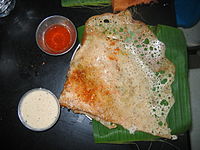
Some common Telugu snacks include:
- Upma (ఉప్మా)
- Boondi (బూంది)
- Kaarappoosa (కారప్పూస)
- Ponganalu (పొంగనాలు)
- Bajji and bondaalu or punukulu (బజ్జి, బోండాలు or పునుకులు), stuffed with spices, dipped in chickpea batter and fried; served with a spicy dip (allam pachadi). Other varieties include mirapakaya bajji (chili), vamu bajji, vankaya bajji (brinjal), aratikaya bajji (plantain), urla gadda bajji (potato), and vegetable bonda.

Samosa vendor on the streets of Hyderabad - Pakodi (పకోడీ)
- Ulli kaadalu pakodi
- Sanna pakodi
- Vankaya pakodi
- Other varieties include royallu pakodi, kodi pakodi, and ullipakodi (fritters made with sliced onion and spices fried in chickpea batter)
- Gaare (గారె), spiced deep-fried dough
- Varieties include:perugu gaare/aavadalu (ఆవడలు), gaare marinated in a yogurt sauce, bellam garelu, rava garelu, ulli garelu, pulla garelu
- Jantikalu (జంతికలు)
- Varieties include pesarapappu jantikalu, challa murukulu, chegodilu(చేగోడీలు), sakinalu or chakkidalu (చక్కిడాలు), chakli, chekkalu or chuppulu (చెక్కలు or చుప్పులు), maida chips, molocasia chips, plain papadam, and aam papad
- Maramaraalu or puffed rice: Usually mixed with tomatoes, onions, coriander, lime juice, and chili powder.
- Bean/pea snacks, such as senagala talimpu and guggillu (గుగ్గిళ్ళు)
- Mixed snacks, such as boondi mixed with chopped onions and lemon juice
Sweets and savories[edit]
This section needs additional citations for verification. (September 2019) |
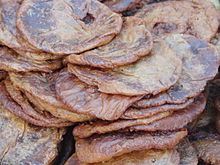



Sweets and savories are typically made on festive and auspicious occasions, and are served to visiting relatives. Some of the savories below are also prepared as an evening snack.
- Pootharekulu, a sweet dish consisting of sweet powder with cardamom flavor stuffed into very thin pancake skins made of rice flour. Pootharekulu was created in Atreyapuram, a village in Andhra Pradesh.
- Kaaja, a deep-fried pastry filled with fruit or soaked in syrup. Variations such as madatha kaaja and kakinada kaaja are eaten across the region.[7][8]
- Sakinalu, one of the most popular savories, is often cooked during the Makara Sankranti festival season. It is a deep-fried snack made of rice flour and sesame seeds, flavored with ajwain (carom seeds or vaamu in Telugu).
- Kajjikayalu: fried dumpling stuffed with suji, dry coconut powder, and sugar. It is usually prepared during Deepavali.
- Sunnundallu, laddu made with roasted urad dal (minapappu) and jaggery (bellam)/ sugar. A generous amount of ghee is usually added to enhance the flavour.
- Ariselu, a sweet fried snack made of rice flour
- Boondi laddu
- Poornam boorelu a.k.a. Poornalu, made by cooking chana dal until soft, cooling, then adding jaggery and cardamom powder. The mix is then rolled into balls, which are subsequently batter-fried. The batter that is used is made from urad dal. This sweet dish is usually served during a festival lunch.
- Rava laddu
- Bhakshalu or bobbatlu or polelu, sweet flatbread made of senega pappu (chickpea flour)
- Tapeswaram kaja
- Pulagam a.k.a. pongali, a sweet dish made on a festival morning as an offering for a deity. Soaked rice is cooked in milk at a ratio of 1:2.5; when the rice is cooked, well-broken jaggery is added. The dish is completed by adding a splash of ghee and fried dry fruit.
- Payasam, a sweet pudding sometimes served in temples[9]
- Gavvalu or "sweet shells" (Telugu: గవ్వలు, gavvalu), deep-fried and sugared balls of flour
- Chakkera pongali (sugar pongal)
- Laskora undalu (coconut laddu) or raskora undalu (coconut laddu)
- Boondi, a fried snack made of chickpea flour[10]
- Palathalikalu, an Indian sweet made during Ganesh Chaturthi
- Ravva kesari
- Pappuchekka
- Jeedilu
- Malai khaja, a traditional sweet from Nellore
- Kobbari lavuju, grated coconut flesh in molten jaggery or sugar syrup
- Vennappalu
Rural cuisine[edit]
In rural Andhra Pradesh, agriculture is the predominant occupation. Some centuries-old cooking practices can still be observed, particularly the use of mud pots, but this practice is being replaced by the use of steel utensils in recent decades. Traditional recipes have largely been influenced by what was grown and available locally earlier in history. In the drier districts, jowar (sorghum), bajra (millet) and ragi are still in use, while eating rice is seen as a symbol of prosperity. In the Delta and coastal districts, rice plays a major role in the cuisine.
References[edit]
- ^ "Humble dishes win hearts, grab spotlight". The Hindu. 29 March 2018. Retrieved 1 September 2019.
- ^ "Andhra Uppu Pindi | Uppudu Pindi (Rice Rava and Moong Dal Upma)". ãhãram. 9 August 2018. Retrieved 31 July 2023.
- ^ "Uggani bajji, a popular dish of Kurnool, steals the show". The Hindu. 24 February 2018. ISSN 0971-751X. Retrieved 31 July 2023.
- ^ "What is Ulavacharu Biryani that's loved by Dulquer Salmaan and how to make it at home". The Times of India. ISSN 0971-8257. Retrieved 31 July 2023.
- ^ "Andhra Chilli Chicken: A Fiery Chicken Recipe From South India That Spells Indulgence". NDTV Food. Retrieved 31 July 2023.
- ^ "Dried fish is a much-loved alternative to fresh fish across the country". The Hindu. 25 August 2020. ISSN 0971-751X. Retrieved 31 July 2023.
- ^ Elizabeth Fernandez, Sugar and spice and all things nice, ISBN 978-1409287223
- ^ Chitrita Banerji, Eating India: An Odyssey into the Food and Culture of the Land of Spices, ISBN 978-1596910188
- ^ "A truly international dessert". Hindustan Times. 3 October 2009.
- ^ Tiwari, Brijesh; Singh, Narpinder (2015). Pulse Chemistry and Technology. Royal Society of Chemistry. p. 271. ISBN 9781782625674.
